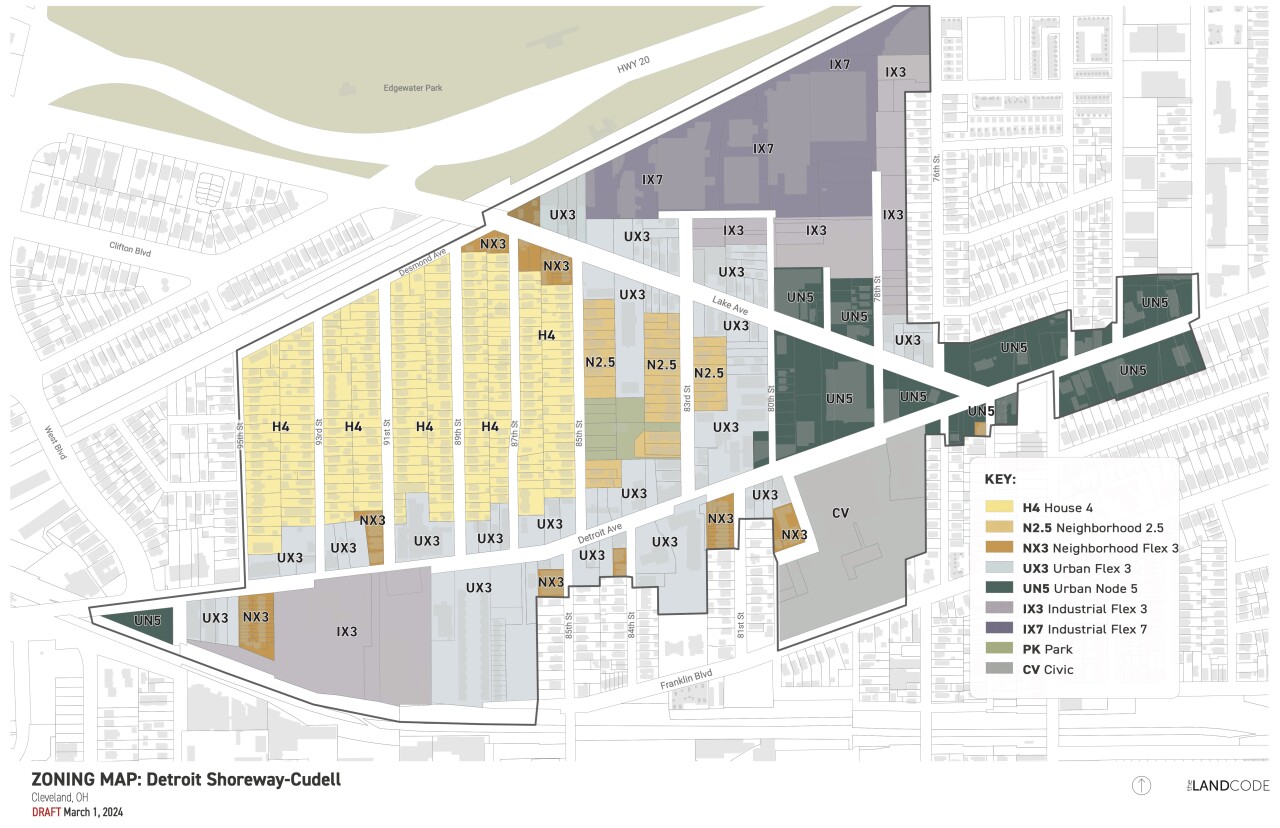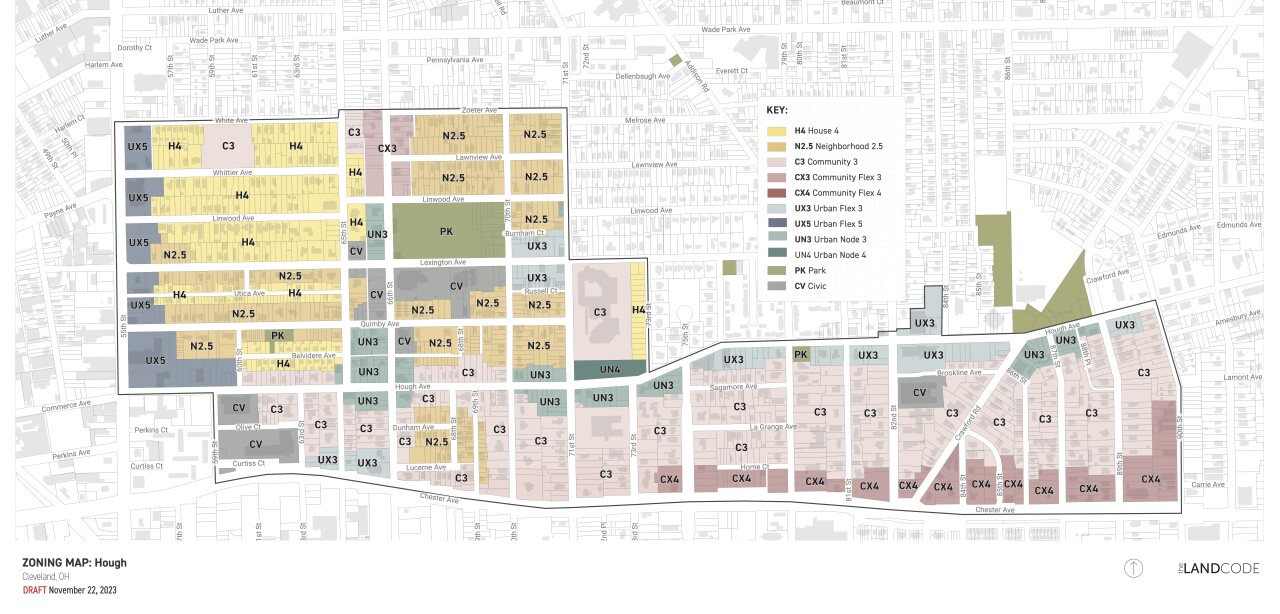CLEVELAND — Cleveland is finally rolling out a new zoning code after six years of planning and a decade of talks.
That might sound dull. But zoning shapes everything that gets built – or blocked – in the city. And it’s an increasingly hot topic across Ohio and the nation as communities struggle with a deep shortage of decent, affordable housing.
“This is the first fundamental change to our zoning code in nearly 100 years, since 1929,” Mayor Justin Bibb told members of the Cleveland City Planning Commission early Friday. “And this administration, with your support, is going to land this plane that has been circling for quite some time.”
The commission approved new form-based code language and maps after a public hearing that lasted nearly three hours. Now, the legislation is headed to City Council for a vote.
The form-based code is a pilot project, an initiative funded by $275,000 in public money and grants. At the outset, it will apply to four areas of the city: Parts of the Detroit Shoreway and Cudell neighborhoods on the West Side, a slice of Hough on the East Side, and a pair of districts along the Opportunity Corridor, where the city aims to lure businesses and jobs.

Eventually, the new code could expand citywide. But that will take years.
“We really believe that in order to democratize planning, zoning – which is highly technical, highly legal – needs to be well understood by all,” said Joyce Pan Huang, the city’s planning director.
“We rank 93rd out of 100, as a city, in terms of private investment,” she said, referring to a recent report from the Urban Institute, a nonprofit research organization. “We fall short with our peer counties when it comes to housing construction and housing supply. Which puts a lot of undue pressure on our current neighborhoods.”
Zoning updates won’t fix those long-simmering problems. But officials believe that clearer regulations and simpler processes will encourage more investment across the city.
“The current zoning code does not work,” Alex Pesta, a principal and partner at Cleveland-based City Architecture, told the commission. “It is a broken, almost 100-year-old document.”

Traditional zoning codes segregate uses, isolating houses from offices, shopping centers and industrial buildings.
The form-based code mixes things up, blending a variety of homes, workspaces, shops, restaurants and other uses. It’s focused on the shape and size of buildings and how they relate to one another – and is less concerned about what’s inside.
That doesn’t mean a developer will be able to build a factory next to single-family homes, cautioned Shannan Leonard, the chief city planner who led the code-reform effort.
The idea is to go back to what cities used to be, with walkable and more inviting neighborhoods. Many of Cleveland’s historic business districts and older homes couldn’t be rebuilt today – at least, not without variances.
Variances, or exceptions to the rules, are routine for projects in Cleveland, whether someone’s adding a deck to a bungalow or building an apartment complex. Navigating the approval process can require a lot of time, money and knowledge.

“We have this body of rules … except for none of the rules actually apply,” said Tom Vanover, the city’s chief building official, during the commission meeting.
He described a convoluted process that the city is trying to simplify.
“You’ve already talked to seven people so that you can talk to nine people so that you can sit before eight people – and then go before a board of another six people,” he said. “And as long as all of those people are with you, are on your side, so to speak, then it works. But if there’s dissent in all of that, and that’s a lot of folks, then moving forward is difficult.”
The form-based code sketches out the scale and type of development the city will allow. It also streamlines the public approval process for smaller residential projects, in particular.
And it makes way for more types of homes – not only single- and two-family houses but also three-unit and four-unit projects. Tiny houses. Backyard apartments. Cluster homes.
That’s appealing to residents like Sonya Shakir, who spoke at the planning meeting. The 50-year-old mother of four lives in the Fairfax neighborhood.
Her youngest child is a teenager, and Shakir wants to downsize. But she hopes to build a modular home – a type of construction that’s still rare and challenging in Cleveland.
“I’m looking forward to aging in place,” she said.

Other residents expressed a mix of enthusiasm and anxiety.
“I do want change,” said Vickie Williams, who lives in the form-based code pilot area in Hough. “I do want to be able to go to restaurants and coffee shops in my neighborhood; however, I do not want large apartment buildings. … We need more single-family homes.”
George Rivers, another Hough resident, applauded the city for trying to drive investment to the East Side, into neighborhoods that have been overlooked for decades.
But, he added, “we just want to make sure that the people that are currently living there, that have invested in the community, don’t get forgotten. That we are a part of what’s going on and that we will enjoy progress with everyone else.”
Leonard, the chief city planner, said the new code should make development more predictable for everyone. It also will allow more Clevelanders to establish home-based businesses, something that’s discouraged under current zoning rules.
“Maybe you make stuff on a Cricut machine, or you’re a candle maker, or you cut hair,” she said during an interview. “As long as it’s appointment-only, it’s at normal hours; it’s not a disruption to your neighbor, you’re not running a commercial enterprise – you can do those things at your home."
The goal, overall, is to make zoning more digestible. And to better reflect residents’ desires, she said.
“We really want to rely on more straightforward, 21st century language, as well as photos and graphics to kind of help people along,” Leonard said.
“We want to be more equitable,” she added. “We want to be more sustainable. We want to be healthier. And all of those things are wrapped up into zoning.”





